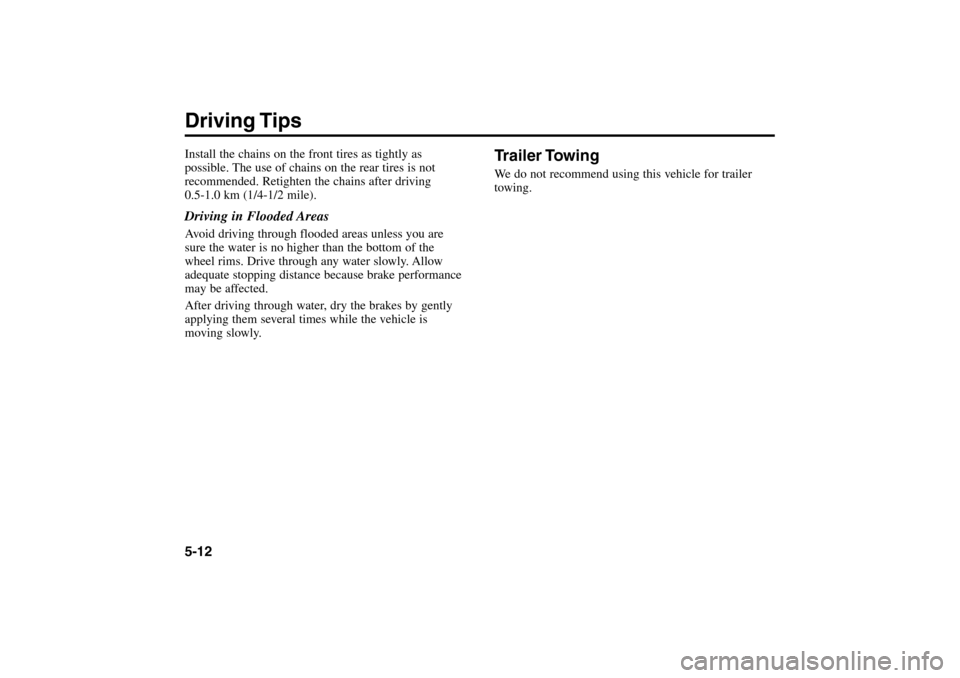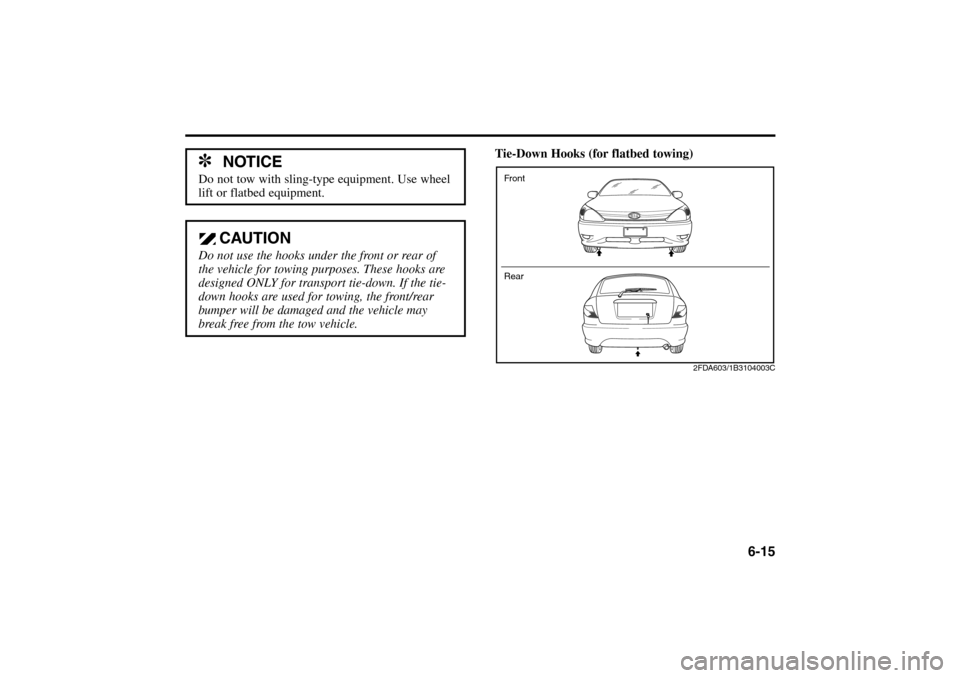2005 KIA Rio towing
[x] Cancel search: towingPage 135 of 238

5-1
DRIVING TIPSFuel Requirements . . . . . . . . . . . . . . . . . . . . . . . . . . . .5-2
Emission Control System . . . . . . . . . . . . . . . . . . . . . . .5-3
Before Driving . . . . . . . . . . . . . . . . . . . . . . . . . . . . . . . .5-4
Suggestions for Economical Operation . . . . . . . . . . . .5-6
Special Driving Conditions . . . . . . . . . . . . . . . . . . . . . .5-7
Trailer Towing . . . . . . . . . . . . . . . . . . . . . . . . . . . . . . .5-12
Overloading . . . . . . . . . . . . . . . . . . . . . . . . . . . . . . . .5-13
Label Information . . . . . . . . . . . . . . . . . . . . . . . . . . . .5-13
5
RIO ENG CNA 5.qxd 7/29/05 5:07 PM Page 1
Page 146 of 238

Trailer TowingWe do not recommend using this vehicle for trailer
towing.
Driving Tips5-12Install the chains on the front tires as tightly as
possible. The use of chains on the rear tires is not
recommended. Retighten the chains after driving
0.5-1.0 km (1/4-1/2 mile).Driving in Flooded AreasAvoid driving through flooded areas unless you are
sure the water is no higher than the bottom of the
wheel rims. Drive through any water slowly. Allow
adequate stopping distance because brake performance
may be affected.
After driving through water, dry the brakes by gently
applying them several times while the vehicle is
moving slowly.
RIO ENG CNA 5.qxd 7/29/05 5:07 PM Page 12
Page 150 of 238

6-1
IN CASE OF AN EMERGENCYRoad Warning . . . . . . . . . . . . . . . . . . . . . . . . . . . . . . . .6-2
Overheating . . . . . . . . . . . . . . . . . . . . . . . . . . . . . . . . .6-2
Emergency Starting . . . . . . . . . . . . . . . . . . . . . . . . . . .6-4
Connection Jumper Cables . . . . . . . . . . . . . . . . . . . . .6-5
Electrical Circuit Protection . . . . . . . . . . . . . . . . . . . . .6-7
Towing . . . . . . . . . . . . . . . . . . . . . . . . . . . . . . . . . . . . .6-14
If You Have a Flat Tire . . . . . . . . . . . . . . . . . . . . . . . . .6-16
6
RIO ENG CNA 6.qxd 7/29/05 5:15 PM Page 1
Page 153 of 238

Emergency StartingJump StartingJump starting can be dangerous if done incorrectly.
Therefore, to avoid harm to yourself or damage to your
vehicle or battery, follow the jump starting procedures
on the next page. If in doubt, we strongly recommend
that you have a competent technician or towing service
jump start your vehicle.
Jump Starting Procedure
1. Make sure the booster battery is 12 volts and that
its negative terminal is grounded.
2. Check the electrolyte level of each of the battery
cells.
3. If the booster battery is in another vehicle, do not
allow the vehicles to touch.In Case Of An Emergency6-4
✽
NOTICE
Use only a 12volt jumper system. You can damage
a 12volt starting motor, ignition system, and other
electrical parts by using a 24-volt power supply
(two 12-volt batteries in series or a 24-volt motor
generator set).
WARNING - Battery
• Keep all flames or sparks away from the
battery. The battery produces hydrogen gas
which may explode if exposed to flame or
sparks.
Do not attempt to jump start vehicle if the
discharged battery is frozen or if the
electrolyte level is low; the battery may
rupture or explode.
RIO ENG CNA 6.qxd 7/29/05 5:15 PM Page 4
Page 163 of 238

In Case Of An Emergency6-14TowingIf emergency towing is necessary, we recommend
having it done by an Authorized Kia Dealer or a
competent tow-truck service. Proper lifting and towing
procedures are necessary to prevent damage to the
vehicle. Provincial and local laws applicable to towing
vehicles must be followed.
As a general rule, towed vehicles should be pulled with
the driving wheels off the ground. If excessive damage
or other conditions prevent towing the vehicle with the
driving wheels off the ground, use wheel dollies.
With either an automatic or manual transaxle:
1. Set the ignition switch in the ACC position;
2. Place the shift lever in N (Neutral);
3. Release the parking brake.
✽
NOTICE
Do not tow the vehicle backward with the front
wheels on the ground. This may cause internal
damage to the transaxle.
AS2B06006AAS2B06007A
Wheel dolly
RIO ENG CNA 6.qxd 7/29/05 5:15 PM Page 14
Page 164 of 238

6-15
✽
NOTICE
Do not tow with sling-type equipment. Use wheel
lift or flatbed equipment.
CAUTION
Do not use the hooks under the front or rear of
the vehicle for towing purposes. These hooks are
designed ONLY for transport tie-down. If the tie-
down hooks are used for towing, the front/rear
bumper will be damaged and the vehicle may
break free from the tow vehicle.
Tie-Down Hooks (for flatbed towing)
2FDA603/1B3104003C
Front
Rear
RIO ENG CNA 6.qxd 7/29/05 5:15 PM Page 15
Page 168 of 238

6-19 Changing Tires
Jacking Instructions
The jack is provided for emergency tire changing only.
Follow jacking instructions to reduce the possibility of
personal injury.Tire Replacement
1. Park on a level surface and set the parking brake
firmly.
2. Set the automatic transaxle in P (Park), or shift the
manual transaxle into R (Reverse).
3. Activate the hazard warning flasher.
4. Remove the wheel lug nut wrench, jack, jack
handle, and spare tire from the vehicle.
5. Block both the front and rear of the wheel that is
diagonally opposite the jack position.
WARNING - Changing Tires
Never attempt vehicle repairs or a tire
change in the traffic lanes of a public road or
highway. Always move the vehicle completely
off the road and onto the shoulder before
trying to change a tire. If you cannot find a
firm, level place off the road, call a towing
service company for assistance.
Do not exceed the maximum permissible
load of the jack: 600 kg. (1,320 lbs).
Be sure to use the correct front or rear
jacking positions on the vehicle; never use
the bumpers or any other part of the vehicle
for jack support.
Never allow any portion of your body to get
beneath the vehicle while using the jack.
Do not start or run the engine while the
vehicle is supported by the jack.
AS2B06012
Flat tire
Wheel block
RIO ENG CNA 6.qxd 7/29/05 5:15 PM Page 19
Page 232 of 238

Interior Care ....................................................................7-52
Interior Features ..............................................................4-40
Interior Lights .................................................................3-65K
eyless Entry System......................................................3-3
Keys ..................................................................................3-2
Label Information ..........................................................5-13
Lighting ...........................................................................4-33
Lubricant Specifications .................................................7-47
Lubricants and Fluids......................................................7-26
Luggage Net ....................................................................3-68M
aintenance Schedule ...................................................7-5
Maintenance Services .......................................................7-3
Manual Transaxle ..............................................................4-7
Mirrors ............................................................................3-62
O
verheating .....................................................................6-2
Overloading.....................................................................5-13
Owner Maintenance ........................................................7-10
Parking Brake ................................................................7-21
Power Outlet ...................................................................3-70
Power Steering.......................................................4-22, 7-22
R
ear Hatch .....................................................................3-54
Rear Window Defroster ..................................................4-38
Road Warning ...................................................................6-2
Roof Rack .......................................................................3-69
Safety Belts ....................................................................3-20
Seats ................................................................................3-11
Special Driving Conditions...............................................5-7
Specifications ................................................................... 8-2
Starting the Engine............................................................4-4
Steering Wheel ................................................................3-62
Suggestions for Economical Operation ............................5-6
Sunglass Holder ..............................................................3-67Tilt Steering ...................................................................4-22
Tires and Wheels.............................................................7-34
Tonneau Cover ................................................................3-71
Towing ............................................................................6-14
Trailer Towing.................................................................5-12
Trunk Lid ........................................................................3-55V
ehicle Break-In Process ................................................1-3
W
arnings and Indicators ...............................................4-27
Windows ...........................................................................3-8
Index9-2
RIO ENG CNA 9.qxd 7/29/05 5:19 PM Page 9-2